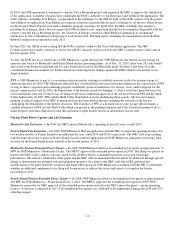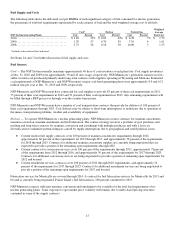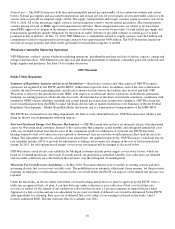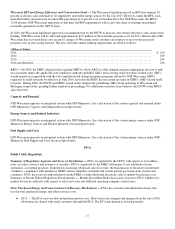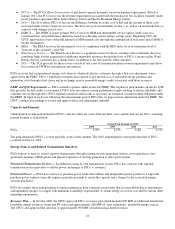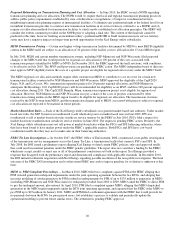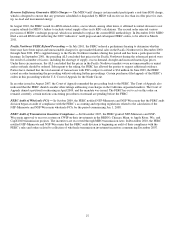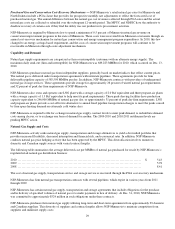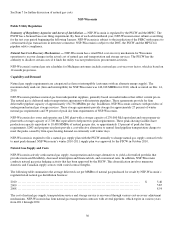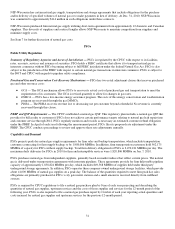Xcel Energy 2010 Annual Report Download - page 32
Download and view the complete annual report
Please find page 32 of the 2010 Xcel Energy annual report below. You can navigate through the pages in the report by either clicking on the pages listed below, or by using the keyword search tool below to find specific information within the annual report.
22
Texas EECRF Rider — PUCT regulations established an EECRF rider under which electric utilities may recover costs associated
with providing energy efficiency programs. The EECRF rider must be included in a utility’s tariff and may be established in a
utility’s base rate case or through a separate request seeking to establish an EECRF. Previously, the PUCT concluded that the rule
did not apply to SPS and that energy efficiency costs should be recovered in base rates. As part of the settlement in SPS’ last base
rate case, SPS reached a negotiated settlement with the parties and included base rate recovery amounts explicitly designated for
energy efficiency. In August 2010, the PUCT adopted a new rule that increases the energy efficiency goals and makes SPS
subject to the same requirements with respect to the EECRF as other utilities in the state. Parties can appeal the application of the
rule to SPS when SPS files for the rider in the spring of 2011.
Jones CCN — In August 2010, the PUCT approved SPS’ request for a CCN to build a gas-fired combustion turbine generating
unit at SPS’ existing Jones Station in Lubbock, Texas. The NMPRC approved a similar CON in December 2010.
New Mexico Energy Efficiency Disincentive Rulemaking — During the 2008 New Mexico legislative session, increased energy
efficiency goals and removal of disincentives were adopted. In 2010, the NMPRC adopted an amended rule incorporating the
legislative changes. The rule had an interim mechanism that provides for recovery of disincentives and required utilities to file
permanent rate design or other means of removing disincentives.
In July 2010, SPS filed its application to remove disincentives and requested direct lost margin recovery. A final approval order
was received in December 2010 totaling $3.3 million for 2010 and 2011. A hearing in this case that focuses on the appropriate
long-term mechanism is scheduled for March 2011.
Solar Contract Approval — In December 2009, SPS entered into five solar energy PPAs with SunEdision, LLC (SunE), for the
procurement of solar energy and associated RECs to meet its solar diversity requirements. The SunE PPAs involve five facilities,
each consisting of 10 MW of capacity for a term of 20 years. In September 2010, the NMPRC approved the SunE PPAs and SPS’
proposed cost recovery.
New Mexico GHG Regulations — In 2010, the New Mexico EIB adopted regulations to limit and reduce GHGs, including CO2
emissions from power plants and other industrial sources. SPS and several other utilities and industry groups have filed separate
appeals with the New Mexico Court of Appeals challenging the validity of these GHG regulations. Compliance costs for these
reductions or offsets may increase electricity rates to New Mexico customers. While regulated utilities generally recover costs
resulting from regulatory requirements, SPS may not recover all costs related to complying with the regulatory requirements
imposed on SPS under the existing EIB regulations. The effect of these regulations on the financial condition of SPS is uncertain,
due to the lack of certainty about the validity of these challenged regulations, and also due to the relatively small proportion of
SPS total greenhouse gases that are emitted in New Mexico.
TUCO Inc. (TUCO) to Woodward District Extra High Voltage (EHV) Interchange — In June 2009, SPP directed SPS to
construct a 178 mile 345 KV transmission line between Lubbock, Texas and Woodward, Okla. The estimated investment in the
new line is $149 million and will be recovered from SPP members, including SPS, in accordance with the SPP OATT and the
retail ratemaking process. Preliminary work has begun for construction from the TUCO substation to the Oklahoma border. TRC
was contracted to do the routing and environmental impact studies. SPS is expected to file an application requesting approval to
build the line in March 2011.
Capacity and Demand
Uninterrupted system peak demand for SPS for each of the last three years and the forecast for 2011, assuming normal weather, is
listed below.
System Peak Demand (in MW)
2008 2009 2010 2011
Forecast
SPS ..................................................................
.
4,996 5,038 4,985 5,142
The peak demand for the SPS system typically occurs in the summer. The 2010 uninterrupted system peak demand for SPS
occurred on Aug. 4, 2010.
Energy Sources and Related Transmission Initiatives
SPS expects to use existing electric generating stations, power purchases and DSM options to meet its net dependable system
capacity requirements.




